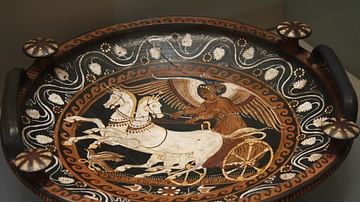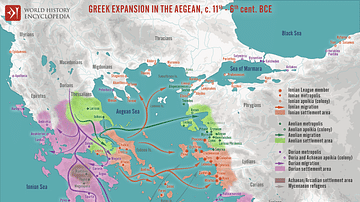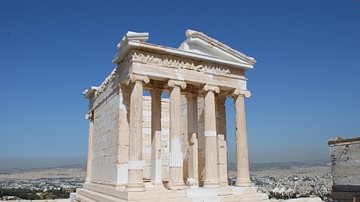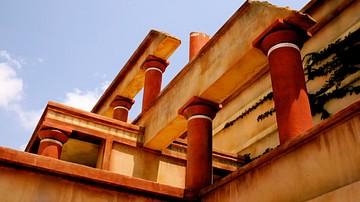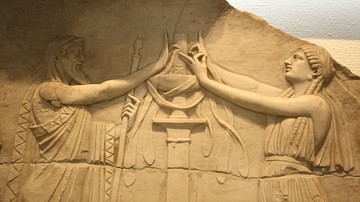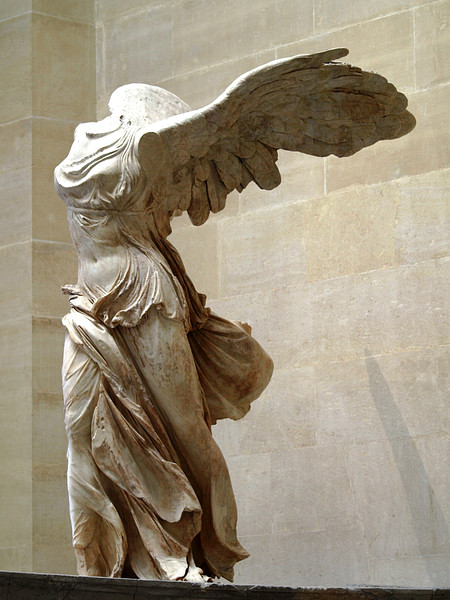
Samothrace (Samothrake) is a Greek island in the northern Aegean which was prominent from the Classical period as a member of the Delian League. Its greatest claim to fame was as a cult centre favoured by Macedon and visited by pilgrims from across the Aegean. Its name today is best known for the magnificent Hellenistic Nike sculpture, the Nike of Samothrace, excavated on the island in the 19th century CE, which is now on display in the Louvre, Paris.
Archaic & Classical Periods
Samothrace, a mountainous Aegean island with an area of 178 km², was first inhabited in the Neolithic period and then colonized by Greek settlers c. 700 BCE, probably from Samos. In literature, Samothrace appears in Homer's Iliad when Poseidon settles himself on the island's mountaintop to watch the spectacle of the Trojan War unfold. The city was ruled by five tribes who had Athena as their patron, and they minted their own coins. In the Persian Wars, we know that at least one ship fought on the side of the Persians (and sunk an Athenian ship) during the Battle of Salamis (480 BCE). Nevertheless, following Greek victory, Samothrace was a tribute-paying member of the Delian League, the alliance of Greek city-states led by Athens, from 478 to 404 BCE. In the same period the island controlled a territory (peraea) on the Thracian mainland where colonies were established. Following a brief period when the island fell under the control of Sparta, Samothrace attracted the interest of Macedon.
Hellenistic & Roman Periods
Samothrace's importance increased dramatically when it received the patronage of the royal house of Macedon, a status which continued through the Hellenistic period. The sanctuary on the island was probably dedicated to the Cabiri (or Kabitoi, perhaps Hermes and Hephaistos here) or the undefined deities known as the Great Gods (Theoi Megaloi, most prominent among them here was likely Axieros, later identified with Demeter). These gods were the focus of a mystery cult which was prevalent across the northern Aegean. According to Herodotus (Bk. 2.52) the cult had been introduced to the island by the Pelasgians centuries earlier.
The cult was second only to the Eleusinian Mysteries in importance in the Greek world. Pilgrims came from afar to seek protection (especially from the sea), moral improvement, a long-life, and a better afterlife. As the name suggests the details of the ceremonies involved at Samothrace remain a mystery, but we do know that first-time initiates (mystai) did whatever they did blindfolded while those already initiated were known as epoptai or 'viewers'. Ceremonies were performed at night and involved dancing. We also know that there was no class, wealth, or nationality barrier to participating in the mysteries and both women and slaves were eligible too.
The Macedonians funded large building projects on the island and it grew to such importance that many Greek city-states sent ambassadors (theoroi) and some of these would remain as proxenoi or permanent residents who looked after the interests of their city at the site. During the Successor Wars following Alexander the Great's death the island switched hands between various Hellenistic rulers but continued to attract visitors to its sanctuary. In the Roman period Samothrace was made a free city giving it certain privileges regarding tax and political autonomy. Part of the Byzantine empire until 1204 CE, it then came under Genoa's rule and was fortified. From the 15th century CE Samothrace was ruled by the Ottomans.
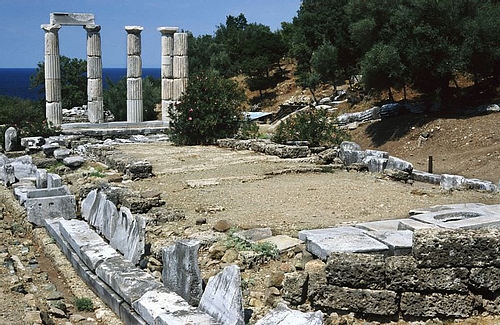
Archaeological Remains
The sanctuary, located at the northern end of the island, was first systematically excavated in the 1930s CE by American archaeologists showing that it once covered 12.5 hectares. This revealed the remains of the largely 4th and 3rd-century BCE buildings and temples. The large temple dates to c. 340 BCE and once had a frieze of dancers, the shrine structure was likely where the mysteries were performed, and the Tholos of Arsinoe (288-281 BCE) was dedicated by Arsinoe, wife of Lysimachus, to the Great Gods. Completing the most important buildings to be seen today, there is a large propylon (monumental gate) dedicated by Ptolemy II Philadelphus in 285-281 BCE, a 3rd-century BCE stoa (colonnaded building), and a palace-like structure dating to the 1st century BCE.
The Nike of Samothrace
However, it is an earlier discovery, made in the 19th century CE, which has brought Samothrace worldwide fame. This is the magnificent marble statue of Victory known as the Nike of Samothrace. The statue was dedicated by worshippers at the cult sanctuary following a naval victory. Dating to c. 190 BCE, the goddess has powerful wings spread and seems to have just landed on a ship's prow. She was set up above an artificial lake at the sanctuary for an even greater dramatic effect. The Nike, considered one of the masterpieces of Hellenistic sculpture, is now on permanent display in the Louvre museum in Paris, France.
Other finds at the site include pottery and stone monuments with Thracian inscriptions. Seals from the Minoan civilization suggest contact with Crete in the Middle Bronze Age. There are fragments of the temple frieze and finds from tombs such as coins and jewellery which are all on display at the site museum. Finally, a famous relief sculpture from the island, also now in the Louvre, depicts a procession of Agamemnon, a herald, and Epeios (maker of the Trojan Horse) who are identified by an inscription. Dating to c. 550 BCE, the scene is an unknown episode from the Trojan War and a reminder that our knowledge of Greek mythology is far from complete.
